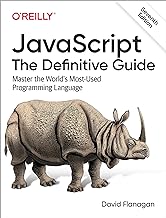JavaScript: The Definitive Guide
Introduction
JavaScript, once a simple scripting language for web browsers, has evolved into a powerful and versatile programming language used for a wide range of applications, from web development
Core Concepts
- Variables and Data Types:
- Declaring variables using var, let, and const.
- Primitive data types: numbers, strings, booleans, null, and undefined.
- Complex data types: objects and arrays.
- Operators:
- Arithmetic, comparison, logical, and bitwise operators.
- Assignment operators.
- Ternary operator.
- Control Flow:
- Conditional statements: if, else if, and else.
- Loops: for, while, and do-while.
- Functions:
- Defining functions using the function keyword.
- Function parameters and arguments.
- Return values.
- Arrow functions.
- Objects:
- Creating objects using object literals and the new keyword.
- Accessing and modifying object properties.
- Prototypal inheritance.
Advanced JavaScript
- DOM Manipulation:
- Accessing and manipulating HTML elements using the Document Object Model (DOM).
- Creating, modifying, and removing elements.
- Event handling.
- Asynchronous JavaScript:
- Callback functions.
- Promises.
- Async/await.
- Modules:
- Importing and exporting modules using ES6 modules and CommonJS.
- Error Handling:
- Using try...catch blocks to handle exceptions.
- Throwing custom errors.
- Regular Expressions:
- Pattern matching and text manipulation.
- Functional Programming:
- Higher-order functions.
- Pure functions.
- Immutability.
- Functional composition.
Modern JavaScript
- ES6 and Beyond:
- New features like arrow functions, let/const, template literals, destructuring, and classes.
- Modules and import/export statements.
- TypeScript:
- Statically typed superset of JavaScript.
- Type annotations, interfaces, and classes.
- Benefits of TypeScript for large-scale applications.
Best Practices
- Code Style and Formatting:
- Using a consistent code style guide (e.g., Airbnb, Google).
- Indentation, spacing, and naming conventions.
- Testing:
- Unit testing with frameworks like Jest.
- Integration testing and end-to-end testing.
- Performance Optimization:
- Minimizing DOM manipulation.
- Efficient use of loops and data structures.
- Lazy loading and code splitting.
- Security:
- Input validation and sanitization.
- Protecting against cross-site scripting (XSS) and cross-site request forgery (CSRF).
- Secure coding practices.
References
- JavaScript: The Good Parts by Douglas Crockford
- You Don't Know JS Series by Kyle Simpson
- Eloquent JavaScript by Marijn Haverbeke
- JavaScript: The Definitive Guide by David Flanagan
Conclusion
JavaScript has evolved into a powerful and versatile language, enabling developers to create complex web applications, mobile apps, and server-side applications. By mastering the core concepts, advanced features, and best practices, you can become a proficient JavaScript developer and build innovative and high-quality applications. Contact ias-research.com for details.



